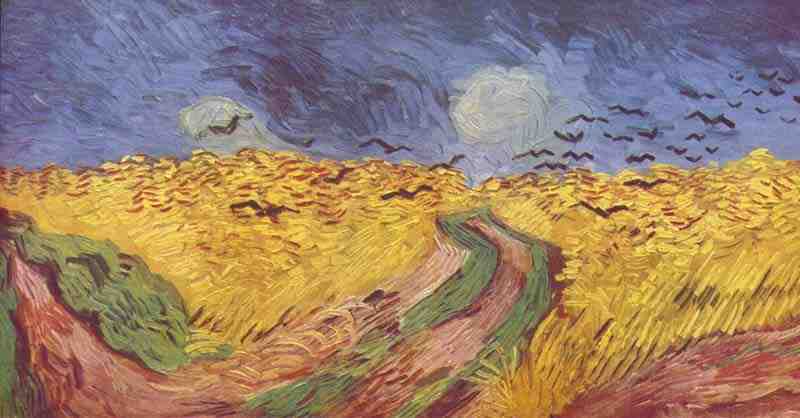
Wheatfield with Crows, Vincent van Gogh
1890, oil on canvas, 51 × 101 cm
Amsterdam, Stedelijk Museum
-----
Getreidefeld mit den Raben, Vincent van Gogh
1890, Öl auf Leinwand, 51 × 101 cm
Amsterdam, Stedelijk Museum
----
---
, 文森特·梵高
---
Fine Art Prints | Greeting Cards | Phone Cases | Lifestyle | Face Masks | Men's , Women' Apparel | Home Decor | jigsaw puzzles | Notebooks | Tapestries | ...
----
Wheatfield with Crows is a July 1890 painting by Vincent van Gogh. It is commonly stated that this was van Gogh's last painting. However, art historians are uncertain as to which painting was van Gogh's last, as no clear historical records exist. The evidence of his letters suggests that Wheatfield with Crows was completed around 10 July and predates such paintings as Auvers Town Hall on 14 July 1890 and Daubigny's Garden.[1][2] Moreover, Jan Hulsker points out that a painting of harvested wheat, Field with Stacks of Wheat (F771), must be a later painting.[3]
Provenance
The Van Gogh Museum's Wheatfield with Crows was painted in July 1890, in the last weeks of van Gogh’s life. Many have claimed it as his last painting, while it is also possible Tree Roots, or the previously mentioned Daubigny's Garden, was his final painting.
Wheat Field with Crows, made on a double-square canvas, depicts a dramatic, cloudy sky filled with crows over a wheat.[1] A sense of isolation is heightened by a central path leading nowhere and by the uncertain direction of flight of the crows. The wind-swept wheat field fills two thirds of the canvas. Jules Michelet, one of van Gogh's favorite authors, wrote of the crow: "They interest themselves in everything, and observe everything. The ancients, who lived far more completely than ourselves in and with nature, found it no small profit to follow, in a hundred obscure things where human experience as yet affords no light, the directions of so prudent and sage a bird."[4] Kathleen Erickson finds the painting as expressing both sorrow and a sense of his life coming to an end.[5] The crows are used by van Gogh as a symbol of death and rebirth, or of resurrection.[6][7] The road, in contrasting colors of red and green, is said by Erickson to be a metaphor for a sermon he gave based on Bunyan's "Pilgrim's Progress" where the pilgrim is sorrowful that the road is so long, yet rejoices because the Eternal City waits at the journey's end.[5][8]
Wheatfield under Clouded Sky (1890)
About 10 July 1890 van Gogh wrote to Theo van Gogh and Jo Bonger, saying that he had painted another three large canvases at Auvers since visiting them in Paris on 6 July.[9] Two of these are described as immense stretches of wheatfields under turbulent skies, thought to be Wheatfield under Clouded Sky and Wheatfield with Crows, and the third is Daubigny's Garden. He wrote that he had made a point of expressing sadness, later adding "extreme loneliness" (de la solitude extrême), but also says he believes the canvases show what he considers healthy and fortifying about the countryside (and adds that he intended to take them to Paris as soon as possible):
There is nothing in van Gogh's words to support a simplistic interpretation along the lines of artistic angst and despair – nor is there any evidence for the widely-held belief that it was this painting that van Gogh had on his easel at the time he killed himself.
—Ingo F. Walther – Rainer Metzger, Van Gogh: The Complete Paintings
Walther and Metzger refer to a June 1880 letter of van Gogh's, in which he compared himself to a bird in a cage,[10] and remark:
The crows in the painting, in other words, were an altogether personal symbol closely associated with van Gogh's own life.
—Ingo F. Walther – Rainer Metzger, Van Gogh: The Complete Paintings
These painting are all examples of van Gogh's elongated double-square canvases, used exclusively by him in the last few weeks of his life, in June and July 1890.
The painting is held in the collection of the Van Gogh Museum in Amsterdam, as is Wheatfield under Clouded Sky.
See also
For other paintings of wheat fields by Van Gogh see Wheat Fields (Van Gogh series).
References
^ to: a b "Wheat Field with Crows". Collection. Van Gogh Museum. Retrieved 31 March 2011.
^ "Auvers-sur-Oise: May – July 1890 (75 paintings)". vggallery.com. Retrieved 29 July 2010.
^ Hulsker, Jan (1986). "The Complete Van Gogh: Paintings, Drawings, Sketches". Random House. p. 480. ISBN 0-517-44867-X.
^ Edwards, C (1989). Van Gogh and God: A Creative Spiritual Quest. Chicago: Loyola Press. pp. 78, 186. ISBN 0-8294-0621-2.
^ to: a b Erickson, K (1998). At Eternity's Gate: The Spiritual Vision Of Vincent Van Gogh. Grand Rapids, MI: William B. Eerdsman Publishing. pp. 103, 148. ISBN 0-8028-3856-1.
^ Werness, Hope B. (2007). Continuum Encyclopedia of Animal Symbolism in World Art. Continuum International. p. 106. ISBN 0-8264-1913-5.
^ Rosenblum, Robert (1975), Modern Painting and the Northern Romantic Tradition: Friedrich to Rothko, p.100, New York: Harper & Row, ISBN 0-06-430057-9
^ "Van Gogh's First Sunday Sermon: 29 October 1876". vggallery.com. Retrieved 17 July 2011.
^ "To Theo van Gogh and Jo van Gogh-Bonger. Auvers-sur-Oise, on or about Thursday, 10 July 1890". Van Gogh Museum. Retrieved 16 July 2011.
^ "To Theo van Gogh. Cuesmes, between about Tuesday, 22 and Thursday, 24 June 1880". Van Gogh Museum. Retrieved 17 July 2011.
Further reading
Erickson, Kathleen Powers. At Eternity's Gate: The Spiritual Vision of Vincent van Gogh, 1998. ISBN 0-8028-4978-4
Walther, Ingo F.; Metzger, Rainer (2010). "Van Gogh: The Complete Paintings". Taschen. pp. 680–682. ISBN 3-8365-2299-3.
Retrieved from "http://en.wikipedia.org/"
All text is available under the terms of the GNU Free Documentation License


